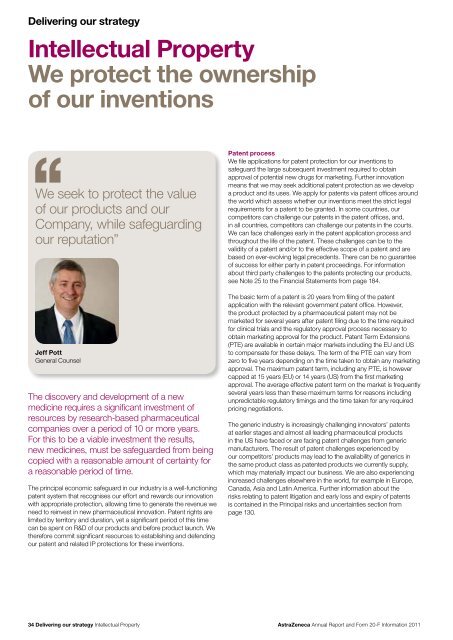AstraZeneca Annual Report and Form 20-F Information 2011
AstraZeneca Annual Report and Form 20-F Information 2011
AstraZeneca Annual Report and Form 20-F Information 2011
- No tags were found...
Create successful ePaper yourself
Turn your PDF publications into a flip-book with our unique Google optimized e-Paper software.
Delivering our strategyIntellectual PropertyWe protect the ownershipof our inventionsWe seek to protect the valueof our products <strong>and</strong> ourCompany, while safeguardingour reputation”Jeff PottGeneral CounselThe discovery <strong>and</strong> development of a newmedicine requires a significant investment ofresources by research-based pharmaceuticalcompanies over a period of 10 or more years.For this to be a viable investment the results,new medicines, must be safeguarded from beingcopied with a reasonable amount of certainty fora reasonable period of time.The principal economic safeguard in our industry is a well-functioningpatent system that recognises our effort <strong>and</strong> rewards our innovationwith appropriate protection, allowing time to generate the revenue weneed to reinvest in new pharmaceutical innovation. Patent rights arelimited by territory <strong>and</strong> duration, yet a significant period of this timecan be spent on R&D of our products <strong>and</strong> before product launch. Wetherefore commit significant resources to establishing <strong>and</strong> defendingour patent <strong>and</strong> related IP protections for these inventions.Patent processWe file applications for patent protection for our inventions tosafeguard the large subsequent investment required to obtainapproval of potential new drugs for marketing. Further innovationmeans that we may seek additional patent protection as we developa product <strong>and</strong> its uses. We apply for patents via patent offices aroundthe world which assess whether our inventions meet the strict legalrequirements for a patent to be granted. In some countries, ourcompetitors can challenge our patents in the patent offices, <strong>and</strong>,in all countries, competitors can challenge our patents in the courts.We can face challenges early in the patent application process <strong>and</strong>throughout the life of the patent. These challenges can be to thevalidity of a patent <strong>and</strong>/or to the effective scope of a patent <strong>and</strong> arebased on ever-evolving legal precedents. There can be no guaranteeof success for either party in patent proceedings. For informationabout third party challenges to the patents protecting our products,see Note 25 to the Financial Statements from page 184.The basic term of a patent is <strong>20</strong> years from filing of the patentapplication with the relevant government patent office. However,the product protected by a pharmaceutical patent may not bemarketed for several years after patent filing due to the time requiredfor clinical trials <strong>and</strong> the regulatory approval process necessary toobtain marketing approval for the product. Patent Term Extensions(PTE) are available in certain major markets including the EU <strong>and</strong> USto compensate for these delays. The term of the PTE can vary fromzero to five years depending on the time taken to obtain any marketingapproval. The maximum patent term, including any PTE, is howevercapped at 15 years (EU) or 14 years (US) from the first marketingapproval. The average effective patent term on the market is frequentlyseveral years less than these maximum terms for reasons includingunpredictable regulatory timings <strong>and</strong> the time taken for any requiredpricing negotiations.The generic industry is increasingly challenging innovators’ patentsat earlier stages <strong>and</strong> almost all leading pharmaceutical productsin the US have faced or are facing patent challenges from genericmanufacturers. The result of patent challenges experienced byour competitors’ products may lead to the availability of generics inthe same product class as patented products we currently supply,which may materially impact our business. We are also experiencingincreased challenges elsewhere in the world, for example in Europe,Canada, Asia <strong>and</strong> Latin America. Further information about therisks relating to patent litigation <strong>and</strong> early loss <strong>and</strong> expiry of patentsis contained in the Principal risks <strong>and</strong> uncertainties section frompage 130.34 Delivering our strategy Intellectual Property<strong>AstraZeneca</strong> <strong>Annual</strong> <strong>Report</strong> <strong>and</strong> <strong>Form</strong> <strong>20</strong>-F <strong>Information</strong> <strong>20</strong>11










